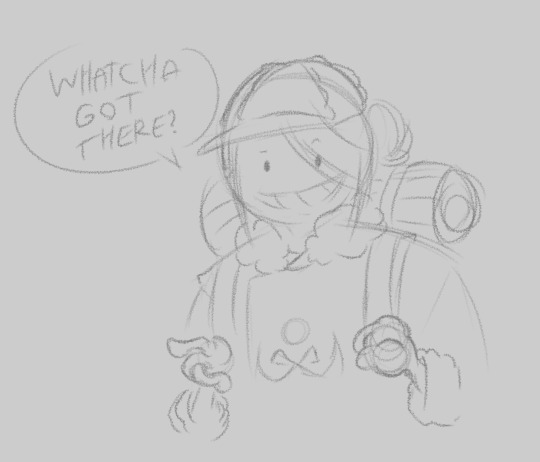#I will be opening regular commissions soon to pay for my Giant Son
Explore tagged Tumblr posts
Text



I may have spent more money than I made at Regionals.
#Emile's Arts#Koro-Sensei#Proship Selfship#Proselfship#I will be opening regular commissions soon to pay for my Giant Son#If anyone is interested just stick around I'll get a post up. Eventually.#Casually draws Koro-Sensei cosplaying Volo#I was actually going to have him cosplay Cynthia but no. I think he'd like Volo#I never played that game but he has the Vibe of a Koro-Sensei fave#I bought this Pichu and was immediately stopped by this girl at one of the tables 'Congrats on the Giant Pichu'#To which I held him above my head and half yelled 'BEEG BABIE'#And then we said the word Gay at eachother back and forth maybe six times (I was wearing my home made rainbow shoes)#So yeah. Good times. I had a great time at Regionals#Like unironically it may have been the most fun thing I've ever gone to#That may have to do more with Regulation H than anything else though#It feels SO much like watching a real in-universe Pokemon battle#Sense there's no legendaries#Just Yanmega VS Klefkei and stuff like than#I had an amazing time I dunno when the next Pokemon event I'll be able to go to will be#But thank y'all who commissioned me for helping me afford to go to this one!#More commissions coming soon!
17 notes
·
View notes
Text
Inside La Colombe d’Or, modern art’s home on the French Riviera
Cannes, France (CNN)Walking around La Colombe d’Or, a casual eye places it among the many inns dotting the French Riviera. This Provencal auberge wears its rustic charm like a badge of honor, or perhaps armor, warding off the dull trappings of the 21st century.
Whitewashed plasterwork, scratched and scuffed, evokes simpler times. The inn’s many nooks and crannies speak of a building that has lived, breathed and grown over the years, before settling into reassuring, unrefined normality.
Discovering the Riviera’s hidden masterpieces
Except there’s nothing normal about La Colombe d’Or. Look closer and artworks start to emerge: a Picasso nestled in one corner, a Matisse in another. In the courtyard outside, an Alexander Calder mobile rotates in the breeze while a Fernand Lger mosaic remains unmoved.
Some of the greatest names in modern art, nonchalantly arranged to look not only as if they belong, but as if they were created here. The thing is, some of them were.
“[The artworks are] completely part of the house, so we don’t think of it anymore,” says the inn’s third-generation owner Daniele Roux. “But you can’t touch them, because the alarm system is so strong.”
Perhaps unsurprisingly, she won’t be drawn on La Colombe d’Or’s insurance value.
Tea with Matisse
The story of La Colombe d’Or (which translates as “The Golden Dove”) is of a family that played the long game. In 1931, farmer’s son Paul Roux and his wife Baptistine opened their restaurant in a secluded corner of Saint-Paul-de-Vence, a medieval hilltop village west of Nice.
Its raison d’etre was bon vivance; good food and good times, a place to while away lazy summer days, eat heartily and drink well.
With a handful of rooms above a bustling eatery, there was nothing remarkable about the inn’s setup. What no one could have anticipated was the clientele drawn to this crumbling bolthole and its unlikely role as a meeting place for the creative elite of the 20th century.
“Portrait of a woman,” by Henri Matisse.
World War I drove many French artists south, where they took up residence along the Cote d’Azur. When peacetime came, some stayed. Among them were Fernand Lger and Georges Braque, who Paul — a versed, if not schooled art admirer — befriended. Alongside them, an aging Henri Matisse.
“He didn’t really come in because at the time he had problems with his legs,” says Paul’s granddaughter-in-law, Daniele. “Paul Roux would spend time with him in [Matisse’s] limousine,” on occasion taking tea.
The artist became a regular at La Colombe d’Or, and others soon followed, either as diners or lodgers.
Actor Yves Montand at the Colombe d’Or in front of a mosaic by Leger, commissioned in the 1950s.
Paul Roux was the fulcrum around which these artistic figures pivoted, “an autodidact and a man of lovely enthusiasm who, having begun to buy paintings, did not hesitate to provide accommodation for certain painters in exchange for their work,” writes Martine Prosper (nee Buchet) in the 1995 book “La Colombe d’Or.”
Paul Roux was admired and respected — a working class Peggy Guggenheim, thoroughly ingratiated with a community of modern artists without being a creative name in his own right. (Under the advice of Matisse, Roux did pick up a paintbrush in later life. His artworks now hang alongside those of his famous friends — one is to the left of the Miro in the main dining room.)
The guests’ wildly different styles, modes and philosophies all found a home under Roux’s roof. Within La Colombe there was commonality and community. Indeed, a sign hung above the inn’s entrance read “Ici on lodge a cheval, a pied ou en peinture” — “Lodgings for man, horse and painters.”
The friendship of Picasso
With the arrival of World War II, life in La Colombe d’Or held a reassuringly even keel, even as both German and American officers both found their way into its guest book.
In the post-war years its reputation was further enhanced. Joan Miro, Marc Chagall and Cesar Baldaccini all added to the inn’s growing art collection.
Pablo Picasso was a regular visitor and became firm friends with Paul. But the Spanish master left no impression on La Colombe’s walls until shortly before Paul’s death in 1953.
Spanish painter Pablo Picasso at the bar of La Colombe d’Or during the 1950s.
“Paul was not well physically, and Tichin [his wife’s nickname] was a strong woman,” recalls Daniele. “She went round to see Picasso and said: ‘You promised you would give him a painting one day.'”
He offered three paintings and Paul chose one. “Flower Vase” still has pride of place. On the day of Paul’s funeral, Picasso was the first to pay his respects.
Post-modernists
Paul’s son Francis took the reigns, but one night in 1959 — disaster. All the paintings were stolen; all except one, a Chagall. The artist came down the next day, most irked, Daniele says. Clearly the thieves had poor taste. (Word spread of the theft and all the paintings were soon returned.)
By the ’60s a new set was frequenting the inn. Intellectuals Jean-Paul Satre and Simone de Beauvoir would stay, while James Baldwin’s fiery rhetoric could often be heard at the dining table. The American iconoclast even relocated to the region after staying at La Colombe in 1970, remaining in the area until his death in 1987.
“The Thumb” by Cesar (1965).
As with so many things on the Cote d’Azur, the inn was not untouched by the Cannes Film Festival. Stars of the “Nouvelle Vague”, Brigitte Bardot and director Francois Truffaut, spent days in the dappled shade of La Colombe’s courtyard, along with Orson Welles, Charlie Chaplin and David Niven, while Roger Moore owned a house nearby. Its glamorous credentials were never in doubt — the kings of Sweden and Belgium, and Edward VIII (then Prince of Wales) all visited in the 1950s.
Successive generations continue to pay pilgrimage.
French literary titan Bernard-Henri Levy has written several of his books at La Colombe. Prosper and Martine Assouline, founders of their eponymous publishing company, based their first title on the inn, such was their adoration.
Episode 14: The allure of French Riviera style
Artworks continue to be added, most recently a giant ceramic apple by Irishman Sean Scully in 2007. New young names are scouted out by Daniele and Francois, though most works lie in storage. By and large, the painters have gone, and the region that inspired them has become a playground for people who buy masterpieces rather than those who paint them.
But three generations in, there’s little sign this Provencal institution will cash out. A precedent was set by Paul Roux many years ago when a wealthy American tried to buy the business. He sent back a bouquet and a note: “These flowers are for you, La Colombe is for my son.”
Daniele laughs at the mention of a fourth generation, batting away the question. “We have a son, we have a daughter, but we’re still here and we’re going to see what happens,” she says. There’s no pressure on them, she insists.
If they one day accept the role, their charge will be to uphold an idiosyncratic space of art and life well lived — to find room, amid the modernist bricolage, for the next chapter of its story.
Read more: http://ift.tt/2sqUyw7
from Viral News HQ http://ift.tt/2rugUNL via Viral News HQ
0 notes
Text
Inside La Colombe d’Or, modern art’s home on the French Riviera
Cannes, France (CNN)Walking around La Colombe d’Or, a casual eye places it among the many inns dotting the French Riviera. This Provencal auberge wears its rustic charm like a badge of honor, or perhaps armor, warding off the dull trappings of the 21st century.
Whitewashed plasterwork, scratched and scuffed, evokes simpler times. The inn’s many nooks and crannies speak of a building that has lived, breathed and grown over the years, before settling into reassuring, unrefined normality.
Discovering the Riviera’s hidden masterpieces
Except there’s nothing normal about La Colombe d’Or. Look closer and artworks start to emerge: a Picasso nestled in one corner, a Matisse in another. In the courtyard outside, an Alexander Calder mobile rotates in the breeze while a Fernand Lger mosaic remains unmoved.
Some of the greatest names in modern art, nonchalantly arranged to look not only as if they belong, but as if they were created here. The thing is, some of them were.
“[The artworks are] completely part of the house, so we don’t think of it anymore,” says the inn’s third-generation owner Daniele Roux. “But you can’t touch them, because the alarm system is so strong.”
Perhaps unsurprisingly, she won’t be drawn on La Colombe d’Or’s insurance value.
Tea with Matisse
The story of La Colombe d’Or (which translates as “The Golden Dove”) is of a family that played the long game. In 1931, farmer’s son Paul Roux and his wife Baptistine opened their restaurant in a secluded corner of Saint-Paul-de-Vence, a medieval hilltop village west of Nice.
Its raison d’etre was bon vivance; good food and good times, a place to while away lazy summer days, eat heartily and drink well.
With a handful of rooms above a bustling eatery, there was nothing remarkable about the inn’s setup. What no one could have anticipated was the clientele drawn to this crumbling bolthole and its unlikely role as a meeting place for the creative elite of the 20th century.
“Portrait of a woman,” by Henri Matisse.
World War I drove many French artists south, where they took up residence along the Cote d’Azur. When peacetime came, some stayed. Among them were Fernand Lger and Georges Braque, who Paul — a versed, if not schooled art admirer — befriended. Alongside them, an aging Henri Matisse.
“He didn’t really come in because at the time he had problems with his legs,” says Paul’s granddaughter-in-law, Daniele. “Paul Roux would spend time with him in [Matisse’s] limousine,” on occasion taking tea.
The artist became a regular at La Colombe d’Or, and others soon followed, either as diners or lodgers.
Actor Yves Montand at the Colombe d’Or in front of a mosaic by Leger, commissioned in the 1950s.
Paul Roux was the fulcrum around which these artistic figures pivoted, “an autodidact and a man of lovely enthusiasm who, having begun to buy paintings, did not hesitate to provide accommodation for certain painters in exchange for their work,” writes Martine Prosper (nee Buchet) in the 1995 book “La Colombe d’Or.”
Paul Roux was admired and respected — a working class Peggy Guggenheim, thoroughly ingratiated with a community of modern artists without being a creative name in his own right. (Under the advice of Matisse, Roux did pick up a paintbrush in later life. His artworks now hang alongside those of his famous friends — one is to the left of the Miro in the main dining room.)
The guests’ wildly different styles, modes and philosophies all found a home under Roux’s roof. Within La Colombe there was commonality and community. Indeed, a sign hung above the inn’s entrance read “Ici on lodge a cheval, a pied ou en peinture” — “Lodgings for man, horse and painters.”
The friendship of Picasso
With the arrival of World War II, life in La Colombe d’Or held a reassuringly even keel, even as both German and American officers both found their way into its guest book.
In the post-war years its reputation was further enhanced. Joan Miro, Marc Chagall and Cesar Baldaccini all added to the inn’s growing art collection.
Pablo Picasso was a regular visitor and became firm friends with Paul. But the Spanish master left no impression on La Colombe’s walls until shortly before Paul’s death in 1953.
Spanish painter Pablo Picasso at the bar of La Colombe d’Or during the 1950s.
“Paul was not well physically, and Tichin [his wife’s nickname] was a strong woman,” recalls Daniele. “She went round to see Picasso and said: ‘You promised you would give him a painting one day.'”
He offered three paintings and Paul chose one. “Flower Vase” still has pride of place. On the day of Paul’s funeral, Picasso was the first to pay his respects.
Post-modernists
Paul’s son Francis took the reigns, but one night in 1959 — disaster. All the paintings were stolen; all except one, a Chagall. The artist came down the next day, most irked, Daniele says. Clearly the thieves had poor taste. (Word spread of the theft and all the paintings were soon returned.)
By the ’60s a new set was frequenting the inn. Intellectuals Jean-Paul Satre and Simone de Beauvoir would stay, while James Baldwin’s fiery rhetoric could often be heard at the dining table. The American iconoclast even relocated to the region after staying at La Colombe in 1970, remaining in the area until his death in 1987.
“The Thumb” by Cesar (1965).
As with so many things on the Cote d’Azur, the inn was not untouched by the Cannes Film Festival. Stars of the “Nouvelle Vague”, Brigitte Bardot and director Francois Truffaut, spent days in the dappled shade of La Colombe’s courtyard, along with Orson Welles, Charlie Chaplin and David Niven, while Roger Moore owned a house nearby. Its glamorous credentials were never in doubt — the kings of Sweden and Belgium, and Edward VIII (then Prince of Wales) all visited in the 1950s.
Successive generations continue to pay pilgrimage.
French literary titan Bernard-Henri Levy has written several of his books at La Colombe. Prosper and Martine Assouline, founders of their eponymous publishing company, based their first title on the inn, such was their adoration.
Episode 14: The allure of French Riviera style
Artworks continue to be added, most recently a giant ceramic apple by Irishman Sean Scully in 2007. New young names are scouted out by Daniele and Francois, though most works lie in storage. By and large, the painters have gone, and the region that inspired them has become a playground for people who buy masterpieces rather than those who paint them.
But three generations in, there’s little sign this Provencal institution will cash out. A precedent was set by Paul Roux many years ago when a wealthy American tried to buy the business. He sent back a bouquet and a note: “These flowers are for you, La Colombe is for my son.”
Daniele laughs at the mention of a fourth generation, batting away the question. “We have a son, we have a daughter, but we’re still here and we’re going to see what happens,” she says. There’s no pressure on them, she insists.
If they one day accept the role, their charge will be to uphold an idiosyncratic space of art and life well lived — to find room, amid the modernist bricolage, for the next chapter of its story.
Read more: http://ift.tt/2sqUyw7
from Viral News HQ http://ift.tt/2rugUNL via Viral News HQ
0 notes